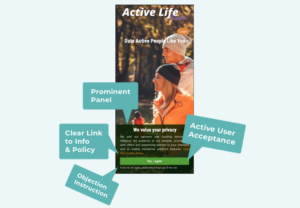How to comply with the Cookie Policy? A real world example
Google has stepped up enforcement of the new User Consent Policy or more commonly known as the “Cookie Policy” last week (21st May 2020). We have seen a lot of misinformation and poorly conceived advice in relation to these policies and updates. I wanted to share with you what we have done to comply with this policy and our real world data and insights in doing so.
Does this apply to me?
If you have a website and you want to attract customers from the EU via Google then this applies to you.
What do I need to do to comply?
Google has provided a very helpful set of resources to explain what you should be doing but it is a bit text heavy. We are presenting our interpretation here as an aid but it should not be a substitute for using their sources directly. There is more you can provide in terms of progressive opt outs of tracking but this covers the basics. You also need to keep a record of the user’s acceptance of these terms. Please see the graphic below for some of the key elements.

What impact will it have on my marketing costs?
I hear you say: “but I have slaved over my design and marketing copy and now have to put this dirty big panel over it. Will it ruin my conversion?”.
Potentially yes. I have seen several different results that are entirely reflective of their marketing campaign setup. Specifically for Google Ads campaigns, we have seen increases in cost per registration. Our stats taken before and after on a Google Ads campaign show that this Consent panel will negatively impact your click to registration rates by up to 3%. In the most affected campaign, the user cost per acquisition (CPA) went from £2.49 to £2.64, an increase of 6%. It will impact conversion but maybe not in the way you think.
What about the profitability of campaigns?
And now the good news. We have seen an improvement in the upgrade rate (% of free users choosing a paid subscription) but about ) 0.5-1.0% in like for like conversion before and after the update. This more than makes up for the slightly higher CPA costs so your campaigns will be more profitable than ever.
It makes sense, if you think about it. The users who do not want to consent to have a cookie placed on your site are likely not the people who will want to furnish you with their highly personal information including sexual preferences and billing information. In this regard Google has provided you with a mandatory pre-lander requirement for your site.
Is there a wider marketing impact?
Yes. At present we are seeing a significant increase in the Impression share (% of users targeted by the campaign seeing adverts) in the range of 10-40% depending on the campaign. I suspect this is due to less competition as other Advertisers are blocked from advertising until they can make their sites compliant again.
Over the last 4 days since stricter enforcement commenced our daily registrations in the UK have risen by 25%. This demonstrates that there is a great opportunity to increase your market share even if the CPA costs are slightly higher.
What’s the longer term impact?
As with all changes in Google-land there are winners and losers with each update. Get used to the new CPA and upgrade rate numbers as like many other aspects of life they will become the new normal.
If your campaigns are targeting a well defined audience in a clear way it will have little to no impact on you. What’s more you might love the fact that your new customers are already in the affirming frame of mind when joining your service, thanks to Google’s update.
If you are relying on less targeted approaches, click bait, redirects and other tactics to lure users to your site that wasn’t quite what they expected, then this popup could prove more of a hurdle.
Is it good for the consumer?
So many of these laws and directives do have noble aims which can be lost in the implementation. I can tell you that we have seen a 7 fold increase in views to our Cookie Policy since it was updated. That’s seven times more customers being fully informed about how we plan to care for them and their data, which can only be a good thing.
This sounds like a great success until you look at this number in the context of the user population visiting on the same day. We are now confident that 0.39% of users have at least clicked on our policy – with a link perilously close to the accept button. That’s up from 0.06% prior to this. I’m just not sure how many of them have read it.

